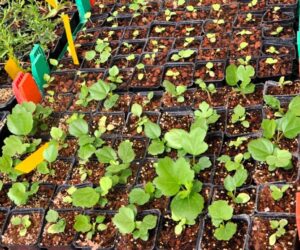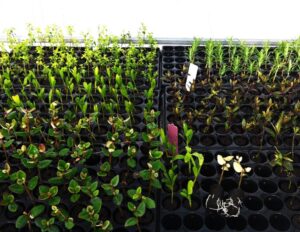
Preformed plugs or a conventional cutting mix?
By Dan Austin
When it comes to plant propagation there are a few key areas to achieve production success. When growing maximum numbers in minimal space, quality, uniformity, and speed all come into play and they are all influenced by one thing – growing media.
I’ve used all sorts of mediums or ‘substrates’ over the years. From conventional ingredients like sand, composted pine bark, and peat moss in Australia, to using tuff (a type of rock made of volcanic ash ejected during a volcanic eruption with similar properties to scoria) in Israel. We even used a mixture of brewery waste, pig manure, and hand-processed coconut husks in the Solomon Islands. Sometimes it is a matter of working with what is cheaply available.

However, in the world of plant production, you get what you pay for and as propagation is where everything starts, it is important that money is well spent. Historically, when training students, I have propagated plants using traditional cutting mixes, low in nutrition, with high aeration and drainage to encourage root growth. The benefit of these mixes is that they can be modified for the species being propagated. Materials used for aeration can include perlite, pumice, diatomaceous earth, and gravel, and can be increased or decreased to suit not only the plant species but the individual irrigation system of an operation.
These mixes can also be used as all-rounders, suited to growing cuttings in various containers from flat trays to tubes and larger-sized pots, and cutting material of any size. These substrates do have their drawbacks though. There is a lot of labour or energy input involved with mixing and filling containers. When growing in flat trays, if disease occurs it can quickly spread to all cuttings in a tray, although this can be mitigated with fungicides or propagating into individual tubes within a tray.
Another issue with these mixes, not often considered, is the damage the materials used to aid aeration and drainage can cause to the fine root hairs of plants when containers are moved around. Sharp, rigid, and abrasive surfaces can cause this damage, no matter how carefully a tray of plants is picked up and put down. By far, the worst example I have seen of this is the damage caused by tuff, but excessive gravel can also be an issue, while perlite is a much softer and forgiving addition to increase aeration but is more expensive.

After watching the industry transform to adopt preformed propagation plugs over the years, we decided to finally use some too and after some balancing of the irrigation system, they have produced fantastic results. These plugs are made of various materials including peat, coir and binders, and are said to retain an air content of thirty percent or more, even under heavy misting conditions. They are light, ready-made, simple, and clean. They are easy to ship, minimise transplant shock, and are suited to mechanisation, so it is clear why so many production nurseries use them. In a fast-paced, well-run production setting these are a dream.
At our educational facility, these plugs have performed well although even these have drawbacks in the wrong scenario. With beautiful white roots emerging in weeks or even days, these plugs need to be potted up quickly, which is fantastic for efficiency but when students only have weekly classes, even seven days can be too long for some species, leading to a compromised root system. These plugs are not really suited to larger diameter cutting material either, because the size of a preformed propagation amalgam for larger material would likely be cost-prohibitive. In this case, something like a rock wool cube for propagation may be a cost-effective pre-prepared alternative.
As with most things, one size rarely fits all, but by weighing up the costs, pros, and cons, you should be able to choose a propagation substrate that will suit you and perform best in a given scenario. When you know what you are doing, it is great to be spoiled for choice!
Dan Austin
IPPS Member, Author
Lecturer, TAFE South Australia
M: 049 122 8591
E: daniel.austin@outlook.com
FB: BeyondGreenAustralia
Main photo: The difference in growth caused by the abrasive nature of tuff compared with perlite in a coir blend (Image: Dan Austin)
